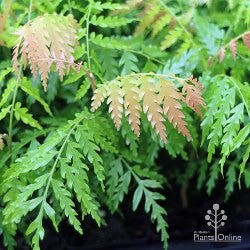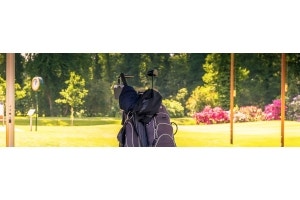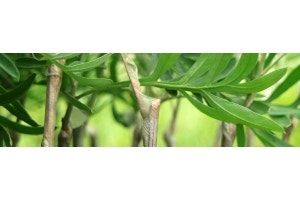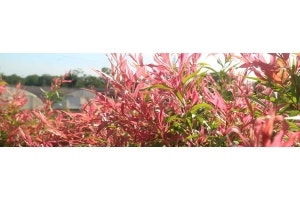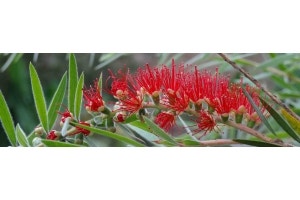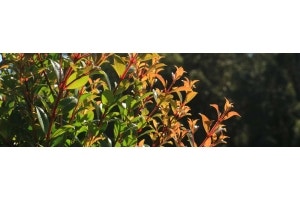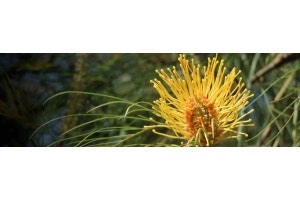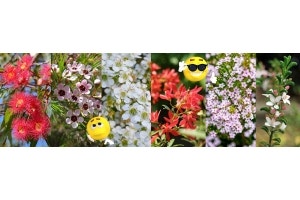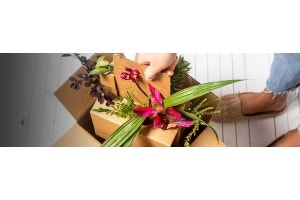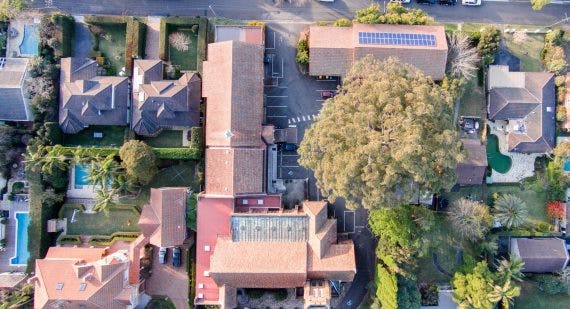
It's lovely to have the luxury of a large acreage garden, and plenty of space to plant large leafy native trees. But many of us live in urban and suburban streets, where space is tight. These man-made locations are the very places that need trees the most - to bring essential cooling shade to the built environment; and to provide visiting birds somewhere to rest on their journey. Which native trees will fit into these tight spaces? We've selected some of our favourite small native trees to squeeze into your garden, however small the space. Take a look at our partner post too, The Best Small Trees for Small Gardens, for small non-native trees for Australian gardens.

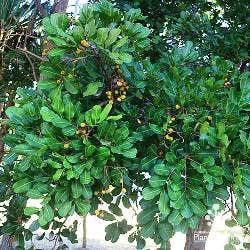 Two of the most popular native street trees we see here in south-east Queensland, where our nursery is, are the tuckeroo (Cupaniopsis) and the tulipwood (Harpullia). They are handsome small trees : both have a solid trunk, attractive foliage, a dense rounded crown, and bright orange berries. Their roots aren't invasive, so you can plant them with confidence near buildings; they both grow quickly, so they will soon establish in your garden; and they never get too tall. Tuckeroo and tulipwood have wide-spreading canopies when mature, creating welcome shade. Remember to allow for this when siting them - perhaps in the corner of your plot where they can lend shade to neighbours' gardens too?
Close relatives cinnamon myrtle or grey myrtle, (Backhousia myrtifolia) and lemon myrtle (Backhousia citriodora), are small, slender neat trees that don't mind a bit of heavy pruning if needed to keep them in check. The abundant fluffy white flowers and aromatic leaves of both these myrtles make them extremely popular with humans and wildlife.
image: gerard
Two of the most popular native street trees we see here in south-east Queensland, where our nursery is, are the tuckeroo (Cupaniopsis) and the tulipwood (Harpullia). They are handsome small trees : both have a solid trunk, attractive foliage, a dense rounded crown, and bright orange berries. Their roots aren't invasive, so you can plant them with confidence near buildings; they both grow quickly, so they will soon establish in your garden; and they never get too tall. Tuckeroo and tulipwood have wide-spreading canopies when mature, creating welcome shade. Remember to allow for this when siting them - perhaps in the corner of your plot where they can lend shade to neighbours' gardens too?
Close relatives cinnamon myrtle or grey myrtle, (Backhousia myrtifolia) and lemon myrtle (Backhousia citriodora), are small, slender neat trees that don't mind a bit of heavy pruning if needed to keep them in check. The abundant fluffy white flowers and aromatic leaves of both these myrtles make them extremely popular with humans and wildlife.
image: gerard
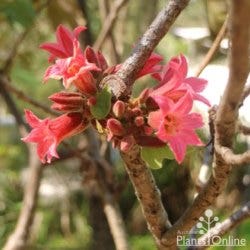 The Prima Donna blueberry ash, (Elaeocarpus), is a really popular tree for frost-free locations, and the size is compact enough for most suburban plots and street tree plantings. For very small gardens, Green Dream is a perfect baby sister, slightly paler of flower and finer of leaf, and about half the size all around; but otherwise almost identical. Kurrajong (Brachychiton bidwillii) might be the perfect small tree for slender spaces - even full grown they won't peek over the roof of your lowset. They decorate their bare spring branches with bright cherry-pink bell flowers before the new leaves arrive; these appear from a very young age, so you can enjoy this native straight out of the blocks.
Looking for something unusual as well as small in size? Here's two beautiful petite native trees that are likely known only to connoisseurs and enthusiasts at present. If you have a frost-free garden the little fireball tree (Asteromyrtus) from Cape York is a pretty choice. We certainly appreciate it in our nursery garden!Related to tea trees but looking more like a bottlebrush, it has vibrant ruby pompom flowers in winter, and airy foliage all year round.Arguably even prettier, is the fern-leaf tamarind, (Sarcotoechia). It's a slow-growing tree with elegantly weeping soft ferny fronds, shaded apple green and bronze-pink, and bright red-and-gold autumn berries.
The Prima Donna blueberry ash, (Elaeocarpus), is a really popular tree for frost-free locations, and the size is compact enough for most suburban plots and street tree plantings. For very small gardens, Green Dream is a perfect baby sister, slightly paler of flower and finer of leaf, and about half the size all around; but otherwise almost identical. Kurrajong (Brachychiton bidwillii) might be the perfect small tree for slender spaces - even full grown they won't peek over the roof of your lowset. They decorate their bare spring branches with bright cherry-pink bell flowers before the new leaves arrive; these appear from a very young age, so you can enjoy this native straight out of the blocks.
Looking for something unusual as well as small in size? Here's two beautiful petite native trees that are likely known only to connoisseurs and enthusiasts at present. If you have a frost-free garden the little fireball tree (Asteromyrtus) from Cape York is a pretty choice. We certainly appreciate it in our nursery garden!Related to tea trees but looking more like a bottlebrush, it has vibrant ruby pompom flowers in winter, and airy foliage all year round.Arguably even prettier, is the fern-leaf tamarind, (Sarcotoechia). It's a slow-growing tree with elegantly weeping soft ferny fronds, shaded apple green and bronze-pink, and bright red-and-gold autumn berries.
Find it a warm sheltered spot to thrive, which should be easy in a cosy urban garden!
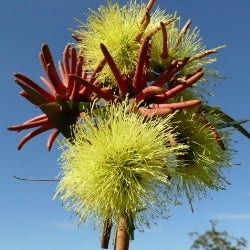 Many native eucalypts are enormous trees, fighting the clouds for sky space and spreading into round wide crowns.
Many native eucalypts are enormous trees, fighting the clouds for sky space and spreading into round wide crowns.
They might be essential koala food, welcome outback shade, and iconic symbols of Australia, but they're no good for suburbia!There's good news for gum-lovers : the plant breeders have been busy lately. There's some fantastic compact brand new native gum trees on the market right now, specially selected and developed to suit smaller garden spaces. Like these new mini-sized Eucalyptus :
Honey Pots, a dwarf southern mallee, whose white fluffy autumn flowers are catnip to birds and bees alike;
Winter Light, a smaller-sized green mallee with airy open branches bright apple-green foliage that let winter light in and give gentle summer shade;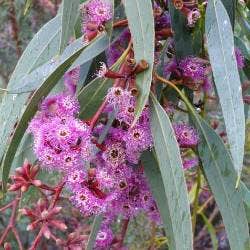 Summer Scentsation, lightly scented as the name suggests, and tolerant of almost any soil type;
Summer Scentsation, lightly scented as the name suggests, and tolerant of almost any soil type;
and the super-popular Purple Patch, those bright magenta pink flowers proving as attractive to us humans as they are to native wildlife. Keep an eye out on our What's New pages as we add more of these mini-gums to our range. They're selling out fast, so we know they are super-popular!If you have patience and green fingers, we also offer seed of the native Illyarrie redcap gum (Eucalyptus erythrocorys) which packs a punch into its petite size - chestnut stems, red buds, lime yellow flowers, and big gumnuts, gving you something to look at every month of the year.
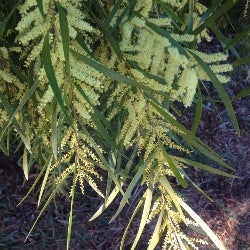 Our national flower, the wattle, can make a ripper little garden tree for compact spaces. They generally have fine soft foliage, slender branches, and they are covered in flowers before they even reach head height. One or two are a bit thuggish, and one or two can reach large proportions; so it pays to choose wisely. The gossamer wattle (Acacia floribunda) is tall and fast-growing, but has very feathery foliage and can be coppiced into a hedge if it ever outgrows your garden. image: Jon Sullivan.The frost-hardy, drought tolerant knife-leaf wattle is somewhere between a large shrub and a small tree - some judicious pruning will encourage an upright trunk. Its roots are non-invasive which means you can plant it near the house without worry.
Our national flower, the wattle, can make a ripper little garden tree for compact spaces. They generally have fine soft foliage, slender branches, and they are covered in flowers before they even reach head height. One or two are a bit thuggish, and one or two can reach large proportions; so it pays to choose wisely. The gossamer wattle (Acacia floribunda) is tall and fast-growing, but has very feathery foliage and can be coppiced into a hedge if it ever outgrows your garden. image: Jon Sullivan.The frost-hardy, drought tolerant knife-leaf wattle is somewhere between a large shrub and a small tree - some judicious pruning will encourage an upright trunk. Its roots are non-invasive which means you can plant it near the house without worry.
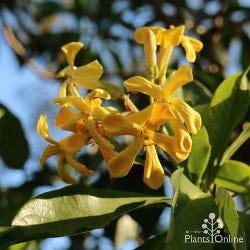 Some native rainforest trees can be surprisingly good candidates for a small space in a bigger garden, if you have the headroom. They've evolved to grow upwards out of the deep shade of the rainforest floor and towards the light, which means while they may end up very tall when full-grown, they are often narrow in profile. (Bear their mature height in mind when siting them, especially if there are overhead cables nearby.)
Some native rainforest trees can be surprisingly good candidates for a small space in a bigger garden, if you have the headroom. They've evolved to grow upwards out of the deep shade of the rainforest floor and towards the light, which means while they may end up very tall when full-grown, they are often narrow in profile. (Bear their mature height in mind when siting them, especially if there are overhead cables nearby.) 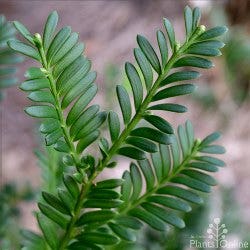 The native frangipani (Hymenosporum) is slender, and flowers while still quite small so you don't need to wait decades to enjoy the golden blossom and sweet scent. We've seen native frangipanis in full flower at less than two metres high. Native Mt Spurgeon pine (Prumnopitys) grows slowly and steadily; so while eventually it might reach heights too large for a pocket-handkerchief garden, you probably won't be around to see it. Meanwhile their dark, ferny, yewtree-like foliage creates gently dappled shade, and the pine's slender profile rarely spreads too wide for a garden border.
The native frangipani (Hymenosporum) is slender, and flowers while still quite small so you don't need to wait decades to enjoy the golden blossom and sweet scent. We've seen native frangipanis in full flower at less than two metres high. Native Mt Spurgeon pine (Prumnopitys) grows slowly and steadily; so while eventually it might reach heights too large for a pocket-handkerchief garden, you probably won't be around to see it. Meanwhile their dark, ferny, yewtree-like foliage creates gently dappled shade, and the pine's slender profile rarely spreads too wide for a garden border.
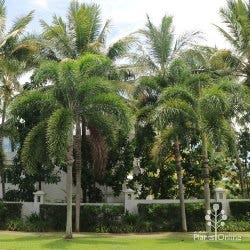 One or two Australian native palms are best left in the rainforest, but there's heaps of smaller-sized garden-friendly native palms we can enjoy. One of the best small native palms is the foxtail palm (Wodyetia), ideal for small spaces, forming beautiful feature trees with straight slim stems, topped with distinctive bushy fronds that give the palm its common name. Macarthur palms (Ptychosperma) grow shorter in shade than in full sun, which makes them a useful choice for urban back yards, and planting under larger established trees in more exposed gardens. They are a clumping palm that can be easily thinned to suit the space available.
One or two Australian native palms are best left in the rainforest, but there's heaps of smaller-sized garden-friendly native palms we can enjoy. One of the best small native palms is the foxtail palm (Wodyetia), ideal for small spaces, forming beautiful feature trees with straight slim stems, topped with distinctive bushy fronds that give the palm its common name. Macarthur palms (Ptychosperma) grow shorter in shade than in full sun, which makes them a useful choice for urban back yards, and planting under larger established trees in more exposed gardens. They are a clumping palm that can be easily thinned to suit the space available.
 Still not convinced you have room for a native tree? Well, if trees can grow in the shallow soil and restricted space of these rooftops in Monaco, Japan, and in the famous Bosco Verticale balconies in Milan, they can grow in your back yard! With modern advances in plant breeding, there's tiny native trees for even the most pocket-sized of plots.
Still not convinced you have room for a native tree? Well, if trees can grow in the shallow soil and restricted space of these rooftops in Monaco, Japan, and in the famous Bosco Verticale balconies in Milan, they can grow in your back yard! With modern advances in plant breeding, there's tiny native trees for even the most pocket-sized of plots.
So you see - even in the smallest of spaces, there's room for a native tree!Use our Plant Height filter on our website to find one that's the right height for your space. You'll find it on the left side on desktop, and at the end of the screen on mobile.

There's always room for a tree
These images from urban places around the world - Poland, US, Italy - show that however built up the place and however small the space, you can squeeze a tree in. The main challenge to overcome when growing trees in very manmade environments is getting water to their roots. Hard surfaces are not permeable; rainwater does not trickle through pavement and asphalt as it does through soil and grass. Setting up irrigation points at the trunk and if possible the drip line - the reach of the outer point of the tree branches - or being diligent about hand watering, will help.Native Trees For Small Spaces
 Two of the most popular native street trees we see here in south-east Queensland, where our nursery is, are the tuckeroo (Cupaniopsis) and the tulipwood (Harpullia). They are handsome small trees : both have a solid trunk, attractive foliage, a dense rounded crown, and bright orange berries. Their roots aren't invasive, so you can plant them with confidence near buildings; they both grow quickly, so they will soon establish in your garden; and they never get too tall. Tuckeroo and tulipwood have wide-spreading canopies when mature, creating welcome shade. Remember to allow for this when siting them - perhaps in the corner of your plot where they can lend shade to neighbours' gardens too?
Close relatives cinnamon myrtle or grey myrtle, (Backhousia myrtifolia) and lemon myrtle (Backhousia citriodora), are small, slender neat trees that don't mind a bit of heavy pruning if needed to keep them in check. The abundant fluffy white flowers and aromatic leaves of both these myrtles make them extremely popular with humans and wildlife.
image: gerard
Two of the most popular native street trees we see here in south-east Queensland, where our nursery is, are the tuckeroo (Cupaniopsis) and the tulipwood (Harpullia). They are handsome small trees : both have a solid trunk, attractive foliage, a dense rounded crown, and bright orange berries. Their roots aren't invasive, so you can plant them with confidence near buildings; they both grow quickly, so they will soon establish in your garden; and they never get too tall. Tuckeroo and tulipwood have wide-spreading canopies when mature, creating welcome shade. Remember to allow for this when siting them - perhaps in the corner of your plot where they can lend shade to neighbours' gardens too?
Close relatives cinnamon myrtle or grey myrtle, (Backhousia myrtifolia) and lemon myrtle (Backhousia citriodora), are small, slender neat trees that don't mind a bit of heavy pruning if needed to keep them in check. The abundant fluffy white flowers and aromatic leaves of both these myrtles make them extremely popular with humans and wildlife.
image: gerardFellow natives pincushion hakea (Hakea laurina) and willow-leaf hakea (Hakea salicifolia) both have shallow roots, so you can plant them close to buildings without tangling up in pipes and cables. These hakea seem happy to adapt to most garden situations, where the soil is not too rich or high in phosphorus.
 The Prima Donna blueberry ash, (Elaeocarpus), is a really popular tree for frost-free locations, and the size is compact enough for most suburban plots and street tree plantings. For very small gardens, Green Dream is a perfect baby sister, slightly paler of flower and finer of leaf, and about half the size all around; but otherwise almost identical. Kurrajong (Brachychiton bidwillii) might be the perfect small tree for slender spaces - even full grown they won't peek over the roof of your lowset. They decorate their bare spring branches with bright cherry-pink bell flowers before the new leaves arrive; these appear from a very young age, so you can enjoy this native straight out of the blocks.
Looking for something unusual as well as small in size? Here's two beautiful petite native trees that are likely known only to connoisseurs and enthusiasts at present. If you have a frost-free garden the little fireball tree (Asteromyrtus) from Cape York is a pretty choice. We certainly appreciate it in our nursery garden!Related to tea trees but looking more like a bottlebrush, it has vibrant ruby pompom flowers in winter, and airy foliage all year round.Arguably even prettier, is the fern-leaf tamarind, (Sarcotoechia). It's a slow-growing tree with elegantly weeping soft ferny fronds, shaded apple green and bronze-pink, and bright red-and-gold autumn berries.
The Prima Donna blueberry ash, (Elaeocarpus), is a really popular tree for frost-free locations, and the size is compact enough for most suburban plots and street tree plantings. For very small gardens, Green Dream is a perfect baby sister, slightly paler of flower and finer of leaf, and about half the size all around; but otherwise almost identical. Kurrajong (Brachychiton bidwillii) might be the perfect small tree for slender spaces - even full grown they won't peek over the roof of your lowset. They decorate their bare spring branches with bright cherry-pink bell flowers before the new leaves arrive; these appear from a very young age, so you can enjoy this native straight out of the blocks.
Looking for something unusual as well as small in size? Here's two beautiful petite native trees that are likely known only to connoisseurs and enthusiasts at present. If you have a frost-free garden the little fireball tree (Asteromyrtus) from Cape York is a pretty choice. We certainly appreciate it in our nursery garden!Related to tea trees but looking more like a bottlebrush, it has vibrant ruby pompom flowers in winter, and airy foliage all year round.Arguably even prettier, is the fern-leaf tamarind, (Sarcotoechia). It's a slow-growing tree with elegantly weeping soft ferny fronds, shaded apple green and bronze-pink, and bright red-and-gold autumn berries.Find it a warm sheltered spot to thrive, which should be easy in a cosy urban garden!
Small Slim Gums For Backyards
 Many native eucalypts are enormous trees, fighting the clouds for sky space and spreading into round wide crowns.
Many native eucalypts are enormous trees, fighting the clouds for sky space and spreading into round wide crowns. They might be essential koala food, welcome outback shade, and iconic symbols of Australia, but they're no good for suburbia!There's good news for gum-lovers : the plant breeders have been busy lately. There's some fantastic compact brand new native gum trees on the market right now, specially selected and developed to suit smaller garden spaces. Like these new mini-sized Eucalyptus :
Honey Pots, a dwarf southern mallee, whose white fluffy autumn flowers are catnip to birds and bees alike;
Winter Light, a smaller-sized green mallee with airy open branches bright apple-green foliage that let winter light in and give gentle summer shade;
 Summer Scentsation, lightly scented as the name suggests, and tolerant of almost any soil type;
Summer Scentsation, lightly scented as the name suggests, and tolerant of almost any soil type; and the super-popular Purple Patch, those bright magenta pink flowers proving as attractive to us humans as they are to native wildlife. Keep an eye out on our What's New pages as we add more of these mini-gums to our range. They're selling out fast, so we know they are super-popular!If you have patience and green fingers, we also offer seed of the native Illyarrie redcap gum (Eucalyptus erythrocorys) which packs a punch into its petite size - chestnut stems, red buds, lime yellow flowers, and big gumnuts, gving you something to look at every month of the year.
Mini Wattles
 Our national flower, the wattle, can make a ripper little garden tree for compact spaces. They generally have fine soft foliage, slender branches, and they are covered in flowers before they even reach head height. One or two are a bit thuggish, and one or two can reach large proportions; so it pays to choose wisely. The gossamer wattle (Acacia floribunda) is tall and fast-growing, but has very feathery foliage and can be coppiced into a hedge if it ever outgrows your garden. image: Jon Sullivan.The frost-hardy, drought tolerant knife-leaf wattle is somewhere between a large shrub and a small tree - some judicious pruning will encourage an upright trunk. Its roots are non-invasive which means you can plant it near the house without worry.
Our national flower, the wattle, can make a ripper little garden tree for compact spaces. They generally have fine soft foliage, slender branches, and they are covered in flowers before they even reach head height. One or two are a bit thuggish, and one or two can reach large proportions; so it pays to choose wisely. The gossamer wattle (Acacia floribunda) is tall and fast-growing, but has very feathery foliage and can be coppiced into a hedge if it ever outgrows your garden. image: Jon Sullivan.The frost-hardy, drought tolerant knife-leaf wattle is somewhere between a large shrub and a small tree - some judicious pruning will encourage an upright trunk. Its roots are non-invasive which means you can plant it near the house without worry.
Rainforest Trees
 Some native rainforest trees can be surprisingly good candidates for a small space in a bigger garden, if you have the headroom. They've evolved to grow upwards out of the deep shade of the rainforest floor and towards the light, which means while they may end up very tall when full-grown, they are often narrow in profile. (Bear their mature height in mind when siting them, especially if there are overhead cables nearby.)
Some native rainforest trees can be surprisingly good candidates for a small space in a bigger garden, if you have the headroom. They've evolved to grow upwards out of the deep shade of the rainforest floor and towards the light, which means while they may end up very tall when full-grown, they are often narrow in profile. (Bear their mature height in mind when siting them, especially if there are overhead cables nearby.)
Brighter spaces reduce the need to fight for sunlight, and drier climates reduce the water available, so growth is slower and denser in the average garden than in the rainforest.
 The native frangipani (Hymenosporum) is slender, and flowers while still quite small so you don't need to wait decades to enjoy the golden blossom and sweet scent. We've seen native frangipanis in full flower at less than two metres high. Native Mt Spurgeon pine (Prumnopitys) grows slowly and steadily; so while eventually it might reach heights too large for a pocket-handkerchief garden, you probably won't be around to see it. Meanwhile their dark, ferny, yewtree-like foliage creates gently dappled shade, and the pine's slender profile rarely spreads too wide for a garden border.
The native frangipani (Hymenosporum) is slender, and flowers while still quite small so you don't need to wait decades to enjoy the golden blossom and sweet scent. We've seen native frangipanis in full flower at less than two metres high. Native Mt Spurgeon pine (Prumnopitys) grows slowly and steadily; so while eventually it might reach heights too large for a pocket-handkerchief garden, you probably won't be around to see it. Meanwhile their dark, ferny, yewtree-like foliage creates gently dappled shade, and the pine's slender profile rarely spreads too wide for a garden border. Pocket-Sized Palms for Gardens
 One or two Australian native palms are best left in the rainforest, but there's heaps of smaller-sized garden-friendly native palms we can enjoy. One of the best small native palms is the foxtail palm (Wodyetia), ideal for small spaces, forming beautiful feature trees with straight slim stems, topped with distinctive bushy fronds that give the palm its common name. Macarthur palms (Ptychosperma) grow shorter in shade than in full sun, which makes them a useful choice for urban back yards, and planting under larger established trees in more exposed gardens. They are a clumping palm that can be easily thinned to suit the space available.
One or two Australian native palms are best left in the rainforest, but there's heaps of smaller-sized garden-friendly native palms we can enjoy. One of the best small native palms is the foxtail palm (Wodyetia), ideal for small spaces, forming beautiful feature trees with straight slim stems, topped with distinctive bushy fronds that give the palm its common name. Macarthur palms (Ptychosperma) grow shorter in shade than in full sun, which makes them a useful choice for urban back yards, and planting under larger established trees in more exposed gardens. They are a clumping palm that can be easily thinned to suit the space available.
 Still not convinced you have room for a native tree? Well, if trees can grow in the shallow soil and restricted space of these rooftops in Monaco, Japan, and in the famous Bosco Verticale balconies in Milan, they can grow in your back yard! With modern advances in plant breeding, there's tiny native trees for even the most pocket-sized of plots.
Still not convinced you have room for a native tree? Well, if trees can grow in the shallow soil and restricted space of these rooftops in Monaco, Japan, and in the famous Bosco Verticale balconies in Milan, they can grow in your back yard! With modern advances in plant breeding, there's tiny native trees for even the most pocket-sized of plots. So you see - even in the smallest of spaces, there's room for a native tree!Use our Plant Height filter on our website to find one that's the right height for your space. You'll find it on the left side on desktop, and at the end of the screen on mobile.





